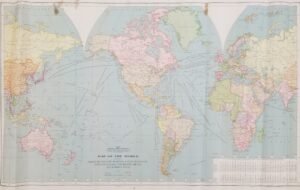Business Route Optimization: Algorithms and Strategies to Reduce Time and Costs

In today’s professional landscape, optimizing travel routes is crucial for the success of any business that involves frequent trips. From home-visiting doctors and sales reps with clients spread across regions to maintenance technicians and couriers—these professionals face the daily challenge of optimizing their routes to maximize efficiency and minimize operational costs.
Switching from a trial-and-error approach to a scientific strategy for route planning can result in significant savings: up to 25% less travel time, 20% lower fuel costs, and a productivity boost of up to 30%. These aren’t just theoretical figures—they’re tangible results achievable with advanced algorithms and targeted optimization strategies.
Foundations of Routing Algorithms
Travel route optimization relies on complex mathematical algorithms that solve what’s commonly known as the “Traveling Salesman Problem” (TSP). While the core idea seems simple, the challenge intensifies with multiple variables:
- Number of Stops: With 10 stops, you’re looking at over 3 million possible route combinations.
- Time Constraints: Opening hours, fixed appointments, delivery windows.
- Traffic Conditions: Rush hours, special events, construction zones.
- Vehicle Features: Load capacity, driving range, restricted access areas.
Key Algorithms for Optimization
- Nearest Neighbor Algorithm: It always chooses the closest unvisited stop from the current position. It’s quick to compute, but can result in suboptimal routes—up to 25% less efficient.
- Genetic Algorithms: These mimic natural evolution to discover optimal solutions, excelling when numerous variables and complex constraints are involved. They require more computing power but outperform traditional methods by 15–20%.
- Local Search: This method starts with an initial solution and incrementally improves it by rearranging the stop order. Algorithms like 2-opt can improve initial routes by up to 30%.
Traffic Intelligence and Real-Time Data
Modern route optimization isn’t just about finding the shortest path—it integrates dynamic data to anticipate and adapt to real road conditions.
Components of Traffic Intelligence:
- Historical Traffic Data: Analyze recurring traffic patterns. For example, Monday mornings at 8:30 a.m. on major roads can be reliably predicted and used to plan alternate routes.
- Real-time Conditions: Incidents, construction, or special events are instantly factored in. Advanced systems can automatically reroute you if delays exceed 20% of historical averages.
- Weather Forecasts: Bad weather can increase travel times by 15–40%. Integrating accurate forecasts helps you plan alternate routes or modify departure times.
Advanced Multi-stop Planning
Multi-stop planning goes beyond just sequencing destinations—it simultaneously optimizes several variables to build a truly efficient travel plan.
Multi-stop Optimization Strategies:
- Geographical Clustering: Group destinations by geographic area before optimizing the order within each cluster. This can cut travel times by 20–35% for pros with clients spread across large metropolitan regions.
- Time Window Optimization: Take into account the availability of each stop. For example, a doctor making house calls needs to coordinate fixed appointments with variable time windows, optimizing both the route and schedule.
- Dynamic Prioritization: Assign different weights to destinations based on business criteria—a critical visit to a strategic client might justify a detour if the opportunity’s value outweighs the added cost.
Smart Appointment Management
Integrating route optimization with appointment management is key to maximizing operational efficiency. It’s not just about visiting all destinations—it’s about doing so at the most strategic times.
Optimized Scheduling Techniques:
- Smart Buffer Times: Automatically calculate buffer time between appointments, factoring in traffic, possible delays, and relative importance of meetings. A sales rep might schedule 15 minutes extra before a strategic visit, but only 5 for routine calls.
- Flexibility Windows: Pinpoint flexible appointments that can be shifted to improve the overall route. Moving one appointment by 30 minutes could save an hour of travel time.
- Contingency Planning: Instantly prepare alternate routes to handle cancellations or unexpected delays. If an appointment falls through, the system can immediately suggest how to make the best use of freed time.
The Value of Historical Tracking
Historical tracking turns each trip into valuable data for future planning. Systematically collecting information on completed routes creates a custom database of operational intelligence.
Key Historical Tracking Metrics:
- Actual vs Predicted Travel Times: Analyzing discrepancies helps you fine-tune prediction algorithms. If a route consistently takes 15% longer than expected, the system learns and adapts future projections.
- Behavior Patterns: Pinpoint personal habits that affect travel times. Some professionals are systematically faster in the morning, others in the afternoon. The system learns these patterns and factors them into planning.
- Efficiency per Client/Destination: Track which clients or destinations yield the greatest value for invested time, optimizing not only routes but also overall business strategy.
Professional Optimization Tools
Choosing the right optimization tools makes the difference between amateur and professional route management.
Essential Features of Professional Tools:
- API Integration: Ability to sync with CRM, appointment schedulers, invoicing platforms. A connected system automatically syncs new appointments and updates routes in real time.
- Mobile Optimization: Mobile-friendly interfaces with offline functionality. Professionals on the move need access to routes and changes even in low-connectivity areas.
- Advanced Reporting: Customizable KPI dashboards to track efficiency, costs, and productivity. Weekly and monthly reports highlight trends and areas for improvement.
Performance Metrics and ROI
Measuring route optimization effectiveness requires specific metrics beyond simple distance reduction.
Core KPIs:
- Time Efficiency: The ratio of productive time (with clients) versus total working hours. The target should be at least 60% for sales roles and up to 80% for specialized technical services.
- Cost per Mile: Includes fuel, vehicle wear-and-tear, tolls, and driver’s time. Effective optimization should reduce this cost by 15–25% in the first year.
- Customer Satisfaction: Appointment punctuality and compliance with agreed time windows. With advanced systems, punctuality above 95% is achievable.
- Revenue per Journey: Revenue earned per travel day. Optimization should enable one extra appointment per day, boosting trip earnings by 15–20%.
Practical Implementation and Best Practices
Deploying a route optimization system requires a methodical approach to drive adoption and concrete results.
Startup Phase:
- Baseline Analysis: Before rolling out optimizations, document current routes, times, and costs for 2–4 weeks. This baseline becomes your reference point to measure improvements.
- Pilot Testing: Start with a subset of recurring destinations to test algorithms and get accustomed to the system. This phase unveils problems and refines parameters before a full rollout.
- Training and Adoption: Invest in training to fully leverage advanced features. Using only 30% of the features yields just 30% of the potential benefits.
Continuous Monitoring:
- Weekly Reviews: Analyze performance weekly to spot trends and anomalies. See whether improvements persist or require tweaks.
- Seasonal Adjustments: Tailor parameters and strategies for seasonal traffic, client schedules, and weather. Summer routes may not suit winter conditions.
- Continuous Learning: Stay up to speed with new algorithms and tech. Route optimization evolves fast, with AI and machine learning rapidly expanding capabilities.
Business route optimization has become a competitive must—not a luxury. Professionals who master these techniques gain substantial advantages in operational efficiency, customer satisfaction, and profitability.
To maximize route optimization benefits in your business, start tracking and analyzing your travels with specialized tools. Download Magica and turn every mile into valuable data to boost your operational efficiency.


